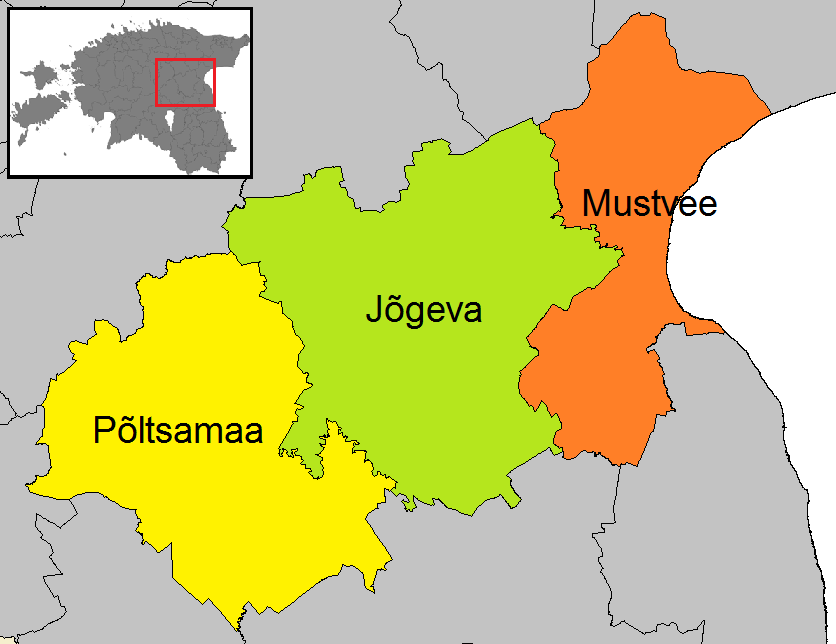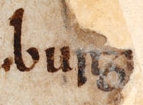|
Adavere
Adavere is a small borough ( et, alevik) in Põltsamaa Parish, Jõgeva County in central Estonia. It has a population of 632 (as of 1 January 2010). Just outside the town is the 'Estonian mainland midpoint symbol denoting'. Adavere Manor Adavere Manor (german: Addafer) was established as an estate in the 17th century. The estate has belonged to several Baltic German aristocratic families during the centuries. The present building was constructed in 1892–1893. Some original interior details survive to this day, and Art Nouveau Art Nouveau (; ) is an international style of art, architecture, and applied art, especially the decorative arts. The style is known by different names in different languages: in German, in Italian, in Catalan, and also known as the Moder ... ceiling decorations were uncovered in 2000. Gallery File:Adavere mõisa peahoone 1.jpg, Adavere Manor File:Adavere mõisa meierei.JPG, Adavere manor dairy File:Adavere kauplus.jpg, Small shop References ... [...More Info...] [...Related Items...] OR: [Wikipedia] [Google] [Baidu] |
Põltsamaa Parish
Põltsamaa ( et, Põltsamaa vald) is a rural municipality of Estonia, in Jõgeva County. It has a population of 2722 (2001) and an area of 416.9 km² (161.0 mi²). Populated places Põltsamaa Parish has one town, 3 small boroughs, and around 60 villages. ; Towns Põltsamaa ; Small boroughs Adavere - Kamari - Puurmani ; Villages Aidu - Alastvere - Altnurga - Annikvere - Arisvere - Esku - Jüriküla - Kaavere - Kablaküla - Kalana - Kaliküla - Kalme - Kauru - Kirikuvalla - Kõpu - Kõrkküla - Kose - Kuningamäe - Kuris - Laasme - Lahavere - Lebavere - Loopre - Luige - Lustivere - Mällikvere - Mõhküla - Mõisaküla - Mõrtsi - Neanurme - Nõmavere - Nurga - Pajusi - Pauastvere - Pikknurme - Pilu - Pisisaare - Pudivere - Puduküla - Puiatu - Räsna - Rõstla - Sopimetsa - Sulustvere - Tammiku - Tapiku - Tõivere - Tõrenurme - Tõrve - Umbusi - Uuevälja - Vägari - Väike-Kamari - Väljataguse - Vitsjärve - Võhmanõmme - Võisik ... [...More Info...] [...Related Items...] OR: [Wikipedia] [Google] [Baidu] |
Populated Places In Estonia
Populated places in Estonia Estonia, formally the Republic of Estonia, is a country by the Baltic Sea in Northern Europe. It is bordered to the north by the Gulf of Finland across from Finland, to the west by the sea across from Sweden, to the south by Latvia, and t ... (officially: settlement units), are cities or settlement units of rural municipalities, but only cities have administrative functions. Settlement units are divided into settlements and urban regions et, asum (subdivisions of cities). Officially there are five types of settlement units in Estonia: *town/city ( et, linn) *town without municipal status () *borough () *small borough () *village () See also * Municipalities of Estonia * List of cities and towns in Estonia * Counties of Estonia Notes External links Place Names Board of Estonia [...More Info...] [...Related Items...] OR: [Wikipedia] [Google] [Baidu] |
List Of Sovereign States
The following is a list providing an overview of sovereign states around the world with information on their status and recognition of their sovereignty. The 206 listed states can be divided into three categories based on membership within the United Nations System: 193 member states of the United Nations, UN member states, 2 United Nations General Assembly observers#Present non-member observers, UN General Assembly non-member observer states, and 11 other states. The ''sovereignty dispute'' column indicates states having undisputed sovereignty (188 states, of which there are 187 UN member states and 1 UN General Assembly non-member observer state), states having disputed sovereignty (16 states, of which there are 6 UN member states, 1 UN General Assembly non-member observer state, and 9 de facto states), and states having a political status of the Cook Islands and Niue, special political status (2 states, both in associated state, free association with New Zealand). Compi ... [...More Info...] [...Related Items...] OR: [Wikipedia] [Google] [Baidu] |
Counties Of Estonia
Counties ( et, maakond, plural ') are the first-level administrative subdivisions of Estonia. Estonian territory is composed of 15 counties, including 13 on the mainland and 2 on islands. The government (') of each county is led by a ' (governor) who represents the national government (') at the regional level. Governors are appointed by the national government for a term of five years. Each county is further divided into municipalities of two types: urban municipalities (towns, ') and rural municipalities (parishes, '). The number and name of the counties were not affected. However, their borders were changed by the administrative reform at the municipal elections Sunday 15 October 2017, which brought the number of municipalities down from 213 to 79. List Population figures as of 1 January 2021. The sum total of the figures in the table is 42,644 km2, of which the land area is 42,388 km2, so that 256 km2 of water is included in the figures. History In the fir ... [...More Info...] [...Related Items...] OR: [Wikipedia] [Google] [Baidu] |
Jõgeva County
Jõgeva County ( et, Jõgeva maakond or ''Jõgevamaa'') is one of 15 counties of Estonia. It is situated in eastern part of the country and borders Ida-Viru County to the north-east, Lake Peipus to the east, Tartu County to the south, Viljandi County to the south-west, Järva County to the north-west and Lääne-Viru County to the north. History Jõgeva County or Jõgevamaa was created January 1, 1990 from a parts of Viljandimaa and Tartumaa counties. County government The County government (Estonian: ''Maavalitsus'') was led by a governor (Estonian: ''maavanem''), who was appointed by the Government of Estonia for a term of five years. Since 2009 until 2018, the Jõgeva County governor position was held by Viktor Svjatõšev. From 01.01.2018 County governments were shut down in Estonia. Municipalities The county is subdivided into municipalities. There are three rural municipalities (Estonian: ''vallad'' – parishes) in Jõgeva County. See also * Vooremaa * Vooremaa ... [...More Info...] [...Related Items...] OR: [Wikipedia] [Google] [Baidu] |
Municipalities Of Estonia
A municipality ( et, omavalitsus, plural ) is the smallest administrative subdivision of Estonia. Each municipality is a unit of self-government with its representative and executive bodies. The municipalities in Estonia cover the entire territory of the country. Municipalities in Estonia are of two types: *Urban municipalities or towns (, singular ) *Rural municipalities or parishes (, singular ). There is no other status distinction between them. Municipalities may contain one or several settlements. All but 5 urban municipalities ( Haapsalu, Narva-Jõesuu, Paide, Pärnu and Tartu) plus 1 rural municipality ( Ruhnu) contain only one settlement. As of 2017, there are no longer any "borough-parishes", i.e. rural municipalities with only one borough-type settlement. Ruhnu Parish contains only one village and is therefore a "village-parish". Some municipalities are divided into districts. The 8 urban districts (, singular ) of Tallinn have limited self-government, while ot ... [...More Info...] [...Related Items...] OR: [Wikipedia] [Google] [Baidu] |
Põltsamaa Valla Lipp1
Põltsamaa (german: Oberpahlen) is a town in Põltsamaa Parish, Jõgeva County, Estonia. The town is situated on the Põltsamaa River, and features a 13th-century castle. Gallery Põltsamaa Jõgi.jpg, Põltsamaa River Põltsamaa Vabadussõja mälestussammas.JPG, Monument to the Estonian War of Independence Põltsamaa Felixi kontorihoone.jpg, Põltsamaa Felix Põltsamaa (german: Oberpahlen) is a town in Põltsamaa Parish, Jõgeva County, Estonia. The town is situated on the Põltsamaa River, and features a 13th-century castle. Gallery Põltsamaa Jõgi.jpg, Põltsamaa River Põltsamaa Vabadussõja m ... is the biggest local employer Põltsamaa kalmistu.JPG, Põltsamaa cemetery References External links Former municipalities of Estonia Cities and towns in Estonia Populated places in Jõgeva County Kreis Fellin {{Jõgeva-geo-stub ... [...More Info...] [...Related Items...] OR: [Wikipedia] [Google] [Baidu] |
Estonia
Estonia, formally the Republic of Estonia, is a country by the Baltic Sea in Northern Europe. It is bordered to the north by the Gulf of Finland across from Finland, to the west by the sea across from Sweden, to the south by Latvia, and to the east by Lake Peipus and Russia. The territory of Estonia consists of the mainland, the larger islands of Saaremaa and Hiiumaa, and over 2,200 other islands and islets on the eastern coast of the Baltic Sea, covering a total area of . The capital city Tallinn and Tartu are the two largest urban areas of the country. The Estonian language is the autochthonous and the official language of Estonia; it is the first language of the majority of its population, as well as the world's second most spoken Finnic language. The land of what is now modern Estonia has been inhabited by '' Homo sapiens'' since at least 9,000 BC. The medieval indigenous population of Estonia was one of the last "pagan" civilisations in Europe to adop ... [...More Info...] [...Related Items...] OR: [Wikipedia] [Google] [Baidu] |
Baltic Germans
Baltic Germans (german: Deutsch-Balten or , later ) were Germans, ethnic German inhabitants of the eastern shores of the Baltic Sea, in what today are Estonia and Latvia. Since their coerced resettlement in 1939, Baltic Germans have markedly declined as a geographically determined ethnic groups in Europe, ethnic group. However, it is estimated that several thousand people with some form of (Baltic) German ethnic identity, identity still reside in Latvia and Estonia. Since the Middle Ages, native German-speakers formed the majority of merchants and clergy, and the large majority of the Baltic nobility, local landowning nobility who effectively constituted a ruling class over indigenous Latvians, Latvian and Estonians, Estonian non-nobles. By the time a distinct Baltic German ethnic identity began emerging in the 19th century, the majority of self-identifying Baltic Germans were non-nobles belonging mostly to the urban and professional middle class. In the 12th and 13th centuri ... [...More Info...] [...Related Items...] OR: [Wikipedia] [Google] [Baidu] |
Art Nouveau
Art Nouveau (; ) is an international style of art, architecture, and applied art, especially the decorative arts. The style is known by different names in different languages: in German, in Italian, in Catalan, and also known as the Modern Style in English. It was popular between 1890 and 1910 during the Belle Époque period, and was a reaction against the academic art, eclecticism and historicism of 19th century architecture and decoration. It was often inspired by natural forms such as the sinuous curves of plants and flowers. Other characteristics of Art Nouveau were a sense of dynamism and movement, often given by asymmetry or whiplash lines, and the use of modern materials, particularly iron, glass, ceramics and later concrete, to create unusual forms and larger open spaces.Sembach, Klaus-Jürgen, ''L'Art Nouveau'' (2013), pp. 8–30 One major objective of Art Nouveau was to break down the traditional distinction between fine arts (especially painting and sculptu ... [...More Info...] [...Related Items...] OR: [Wikipedia] [Google] [Baidu] |
Boroughs And Small Boroughs In Estonia
A borough is an administrative division in various English-speaking countries. In principle, the term ''borough'' designates a self-governing walled town, although in practice, official use of the term varies widely. History In the Middle Ages, boroughs were settlements in England that were granted some self-government; burghs were the Scottish equivalent. In medieval England, boroughs were also entitled to elect members of parliament. The use of the word ''borough'' probably derives from the burghal system of Alfred the Great. Alfred set up a system of defensive strong points (Burhs); in order to maintain these particular settlements, he granted them a degree of autonomy. After the Norman Conquest, when certain towns were granted self-governance, the concept of the burh/borough seems to have been reused to mean a self-governing settlement. The concept of the borough has been used repeatedly (and often differently) throughout the world. Often, a borough is a single town ... [...More Info...] [...Related Items...] OR: [Wikipedia] [Google] [Baidu] |




